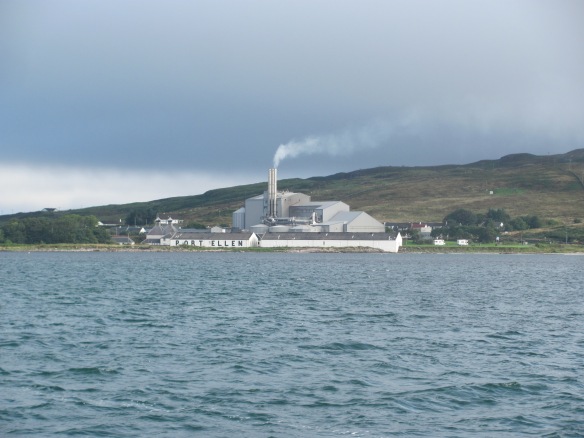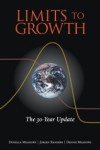We had hoped to explore a few more of the Scottish islands further north, but the weather over the last few days had confined us to shelter in Port Ellen, with more of the same forecast to come in the next week. Today is a favourable window, but as we need to return home for various appointments in a couple of weeks, we have decided to head south again around the Mull of Kintyre for Campbeltown and from there to Ardrossan where we will keep Ruby Tuesday over the winter..

Preparing to leave Port Ellen.
The east-flowing stream around the Mull of Kintyre starts six hours before highwater at Dover, which is at 1200 and continues for six hours until 1800, so we plan on arriving at the Mull lighthouse about mid-way between these two times. We calculate that it will take about 4½ hours to get there from Port Ellen and decide to leave at 0900. Several others have the same idea and for a while we form a neat orderly line as one by one we cast off and motor out past the distillery. Before long, however, we are heading in different directions, some towards the Mull of Kintyre, others toward Bangor in Northern Ireland. The wind is from the north-west, directly behind us, so we goosewing with the genoa poled out.

Passing Port Ellen distillery.
 My mind drifts back to my first year at university. The book ‘Limits to Growth’ by Donella Meadows and her colleagues had just been published and it was required reading for an assignment. In it, the authors describe how a relatively simple computer simulation was developed to capture the dynamics of the world system, and then how it was used to investigate various scenarios of consumption and resource use. They concluded at the time than most scenarios, especially the ‘business as usual’ one, would result in economic collapse. Only a few scenarios would allow civilisation to develop sustainably, but this would have to be done at much lower consumption. Even then, if this didn’t happen by the mid-1980s, then it would be too late to avoid a collapse.
My mind drifts back to my first year at university. The book ‘Limits to Growth’ by Donella Meadows and her colleagues had just been published and it was required reading for an assignment. In it, the authors describe how a relatively simple computer simulation was developed to capture the dynamics of the world system, and then how it was used to investigate various scenarios of consumption and resource use. They concluded at the time than most scenarios, especially the ‘business as usual’ one, would result in economic collapse. Only a few scenarios would allow civilisation to develop sustainably, but this would have to be done at much lower consumption. Even then, if this didn’t happen by the mid-1980s, then it would be too late to avoid a collapse.
Scary stuff, and at the time it caused a lot of controversy. Economists attacked it because it didn’t explicitly include financial flows. Others thought that human ingenuity would always find an answer to our problems and that there was no need to worry, despite improved technology being one of the scenarios they examined. As time went on and civilisation seemed in no danger of collapse, growing stronger if anything, most people consigned it to the dustbin of history.
Until recently, that is. It is now 40 years since the original work, so an Australian scientist thought that it would be a good idea to compare the original predictions with what had happened over those 40 years. What he found was that the business as usual scenario was dead on track with the observed data for many of the variables. Not only were the predictions pretty spot on, the collapse hadn’t occurred yet because it hadn’t been predicted to until the early 21st century. So at the moment they can’t be proved wrong.
The wind goes around to the west slightly, and we have to trim the sails. Goosewinging is no good any more, so we remove the preventer from the mainsail and bring the genoa over to the other side. We are now on a starboard broad reach and continue on our way. For a while we are joined by a small sparrow wanting a rest on the guard rail before fluttering off again. We are amazed at how far out it has flown and hope it makes it home again.
I think of the current trends in world affairs. Liberal democracy and the world order that brought about the tremendous rise in living standards for many and lulled us all into a false sense of security that it would continue forever, is on the run from the rise of nationalism, right-wing politics, and authoritarianism. In the rush towards prosperity, what everyone forgot to keep a check on was the huge inequalities that had built up within and between countries. Now these are kicking back.
After three hours, the wind drops off. I feel a bit worried that we won’t make it to the Mull before the current starts flowing west again preventing us from getting around, but luckily there is enough south-eastwards tidal flow in the North Channel to keep us moving on. We arrive at the lighthouse at 1400, slightly later than planned but still in good time. The water is a bit rough but nothing that Ruby Tuesday can’t handle, and before long we are past the Mull and approaching Sanda Sound.

Passing the Mull of Kintyre light-house.
The wind picks up again and is now on our port beam, and we speed along at a cracking pace up the eastern coast of Kintyre and into the Firth of Clyde where we trim the sails to a close reach. Straight ahead we can see the majestic mountains of Arran, while off to our starboard is the small island of Sanda.

Entering Sanda Sound, with Sanda Island on the right.
We are amused to read that Sanda has had phenomenal growth rate of 300% in its population in recent years, rising from one person to three persons from 2001 to 2008!
Small numbers I know, but I try to imagine what the world would be like with a similar population growth rate. I can’t really. What will the future be like for our offspring, I wonder? Not only have our generation failed to move to a more sustainable lifestyle despite knowing we have to, but we seem to also be descending into the politics of the past, away from cooperation to solve our joint problems towards nationalism. Add to this the ‘hacking’ of the human will by subversion of the truth towards specific ends that Harari talks about. Escaping it all and sailing off into the sunset suddenly has some appeal. Or is all this just doom-mongering, with nothing to worry about that the human spirit won’t be able to overcome? Time will tell.
We are now approaching Island Davaar and behind that, Campbeltown. We find the transit line at 240°, furl the sails, and motor slowly into the harbour. A man gesticulates wildly for us to tie up to the outermost hammerhead pontoon. It turns out he is the marina manager. He helps us tie up next to a motor boat which we know well by now – it is none other than Richard and Maryanne. They invite us over for a drink.

Entering Campbeltown harbour.
That evening, we dine at the Taj Mahal Indian restaurant just up from the marina. Surrounding us are hughly-inflated photographs of the Himalayas and various other scenes in India, reminding me of the time I spent working there in my youth. The waiter comes over and promises us that we would have a meal to remember. Two hours later, we look at each other over the nearly-finished bowls of curry sauce, unfinished naan breads, and the empty glasses of beer. Enough is enough! “I told you that you would remember that, didn’t I”, said the waiter as if he has just proved a scientific theorem. I hope it will be for the right reasons.

The Taj Mahal restaurant, Campbeltown.
Feeling very bloated, we decide to explore around the harbour to walk some of it off. Who should we come across but our old friend Thalassa, the tall ship we had first seen in Ballycastle, then off the coast of Rathlin, then in Port Ellen, and now in Campbeltown. We learn that it is a Dutch ship, available for charter, and that a bunch of friends are on it now travelling around the Scottish islands before making their way over to Bremerhaven.

The Thalassa tall ship.
The next day, we get the bikes out and go for a ride out along the coast to the south of Campbeltown to the point opposite Island Davaar. I am having trouble with the clamp on mine that keeps the seat post up, and every five minutes it disappears back down into the tube to its lowest level so that I end up with my knees brushing my ears. I take a pair of pliers so that I can adjust the tension of the bolt, but it doesn’t seem to make much difference. Something clearly has gone wrong. At least we have the wind to our backs. Ever the optimist, that’s me.
We arrive at the Dorlinn, the causeway between the mainland and Island Davaar. It is still above water, but the tide is rising and it is too risky to try and walk across it to the island. We have no real desire to be marooned on the island until the next tide, and decide to leave it for another time. It’s a pity as apparently there is a cave with a painting of the crucifixion there we would have liked to see. The story goes that it was painted back in the 1880s by a local artist, but the good people of the town thought it was a sign from God. They were not well pleased when they found out it was one of them that had done it.

Island Davaar, Campbeltown.
On the way back, we stop off to visit the Linda McCartney memorial garden in a little area behind the museum. It seems that she was very well liked by the local people in Kintyre after her and Paul McCartney moved there and formed the band Wings, so after she died in 1998 of breast cancer a trust was set up to create the garden. A bronze statue of her was donated by Paul McCartney.

Linda McCartney Memorial garden, Campbeltown.
In the evening, another large boat comes and moors behind us. I give them a hand in tying up. It turns out to be a training ship with a load of youngsters from a school near Glasgow on it. They are with one of their teachers and have chosen sailing as their summer activity. They are fascinated by our ‘small’ boat and want to have a look inside. We invite them in and are amused by their comments that it is ‘cosy’. Their boat is probably twice as long, so it is all relative, I guess.

A visit from our neighbours.

I like your musings, and That Limit to Growth sounds like an interesting read!
LikeLike